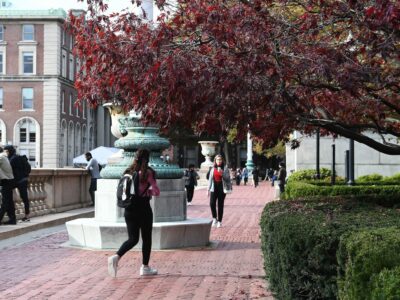
The Columbia Climate School announces the launch of a new dual degree program with the Graduate School of Architecture, Planning and Preservation (GSAPP), beginning in September 2025. Students enrolled in this dual degree program will receive both a Master of Science in Climate and a Master of Science in Architecture and Urban Design upon successful completion of their studies.
Addressing the climate crisis requires leaders who can synthesize knowledge and skills across different fields, and bring those perspectives together to create interdisciplinary climate solutions. By integrating climate expertise with architecture and urban design, the MS in Climate and MS in Architecture and Urban Design dual degree program equips future scholars and practitioners with the tools to build sustainable and climate-responsive communities. “The new Climate School-GSAPP dual degree is a fantastic opportunity for students interested in the intersection of climate and the built environment,” says Climate School interim dean Jeff Shaman. “It provides enrollees deep training in both disciplines and a clear career path for work on adaptation, mitigation and sustainable development.”
“No impact on climate can be made without mobilizing the built environment. This new dual program brings together GSAPP’s leadership in the transformation of the built environment with the Climate School’s pioneering climate and environmental sciences,” says GSAPP dean Andrés Jaque.
The dual degree will train scholars and practitioners to create and manage built environments that support local, low-carbon economies and just, resilient, healthy and prosperous communities—with a strong focus on urban areas. Jason Smerdon, co-director of the MS in Climate program, says, “More than half the world’s population lives in cities and that proportion is growing. At the same time, some of the largest climate risks are associated with urban infrastructure. Joining the study of urban design with climate is therefore critical for educating future leaders to better understand the risks, challenges and opportunities that exist at the interface.” Mingfang Ting, co-director of the MS in Climate program, adds, “As cities continue to grow, they face increasing climate threats, such as extreme heat, floods and rising sea levels. Understanding both the science of climate change and the principles of resilient urban design is critical for creating sustainable cities.”
Students enroll for a total of 77 credits—32 credits over two semesters for the MS in Climate and 45 points over three semesters for the MS in Architecture and Urban Design—thus receiving both degrees in less time than if pursued separately. In the MS in Climate program, students will complete an immersive year of climate courses centered on scientific understanding of climate, quantitative methods, mitigation pathways, adaptation strategies and policies, justice frameworks and societal impacts.
In the MS in Architecture and Urban Design program, students will engage in a multidisciplinary study of cities, regions, infrastructures and ecosystems, focusing on the role of design in redefining the 21st-century urban landscape to meet the challenges of climate change, rapid urbanization and social inequality. “We are so excited to offer this dual degree program for students who are passionate about urban climate solutions and who also understand the power of science and design to sustainably remake our built environment,” says Kate Orff, director of the MS in Architecture and Design Program.
The need for professional expertise in climate-conscious urban strategies has never been higher. Graduates will be well suited for a variety of roles at the intersection of climate and design, in both the public and private sectors. Columbia’s location is an ideal setting for this program, as New York City is a global leader in developing policies at the city level to address climate change resilience and mitigation. Students will have ample opportunities to apply their knowledge outside the classroom across both programs, through internships, capstones, studios and other professional activities to help prepare them for vibrant careers.
Interested candidates must apply separately to the Columbia Climate School and the Graduate School of Architecture, Planning and Preservation. Each school’s admissions decisions are made independently based solely on that school’s selection criteria. Students may begin the dual program in either school, enjoying the same opportunities and benefits of the school in which they reside for each year.




Hi, It does seem a little late to head off the climate crisis, but combining these studies looks great . My life’s work did something similar, combining physics, architecture, natural systems. The latter required creating a new physical science, one for studying natural systems in context, gather than in concept, recognizing them as self-animating and organizing.
I’m wondering, though, do your disciplines have a way to explain why the last 50 years of sustainability effectively backfired, having no effect on the impact growth rates from the runaway economic growth system that seems to be the central origin of all our big crises?